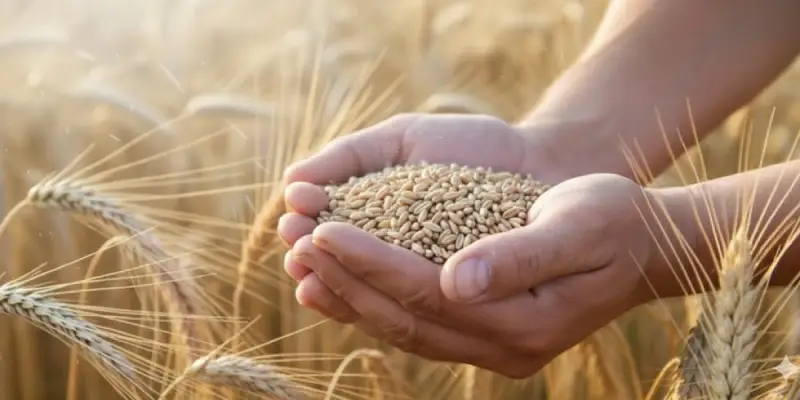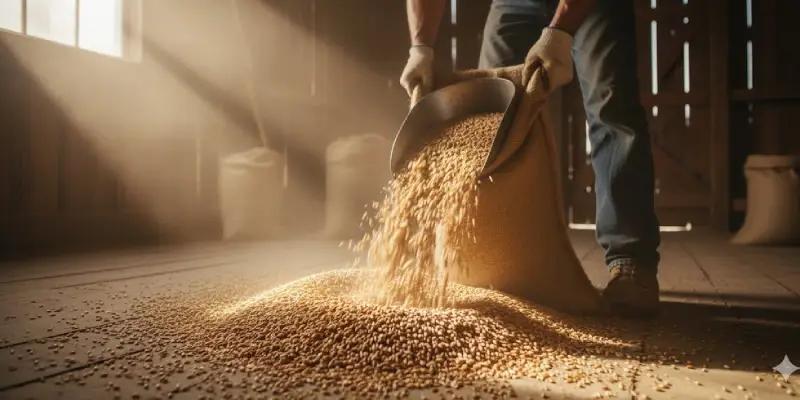Wheat price in Pakistan matters a lot for farmers in fields and families in cities. Wheat is a staple food here. So when its price goes up a little, it makes life harder for households and affects a farmer’s earnings.
We need to know what things make the wheat price go up or down, so people can understand the market better.
Today, Tuesday, October 7, 2025, the wheat price in Pakistan is between PKR 2,700 to PKR 3,690 per 40kg
Prices differ from one province to another Punjab, Sindh, Khyber Pakhtunkhwa because of transport costs, supply, and government policies.
We will look at the latest wheat market trends, what factors push prices up or down, and how these changes shape Pakistan’s food and farming situation.

Table of Contents
ToggleCurrent Wheat Prices in Pakistan
| City | Current Wheat Price (PKR/kg) | Urban/Rural |
| Lahore | 3640 | Urban |
| Karachi | 3660 | Urban |
| Islamabad | 3,660 | Urban |
| Faisalabad | 3680 | Urban |
| Peshawar | 3650 | Urban |
| Multan | 3640 | Urban |
| Quetta | 3660 | Urban |
| Rural Areas | 2880 | Rural Average |
Recent Trends
In recent months, the wheat price in Pakistan has been slowly increasing. This rise is mostly due to higher demand and supply chain issues across the country.
In big cities like Lahore, Karachi, and Islamabad, wheat prices have gone up as transport and storage costs increased. Many flour mills are also facing higher expenses, which adds pressure on the market.
In rural areas, the price is usually lower because wheat is grown locally, and farmers sell it directly without big transportation costs. However, the gap between urban and rural prices shows how uneven market access and government support can be.
The current trend shows that wheat prices in Pakistan may stay high in the coming months if supply problems and global food prices continue.
Wheat Cutting Machine Price in Pakistan
Modern farming tools are helping farmers save time and increase production. The wheat cutting machine price in Pakistan depends on the type, size, and working capacity of the equipment.
| Type of Machine | Price Range (PKR) | Impact on Harvesting Efficiency |
| Hand-held Reapers | 15,000 – 40,000 | Ideal for small farms; low cost but limited efficiency. |
| Self-Propelled Harvesters | 1,500,000 – 3,500,000 | High efficiency; suitable for large-scale operations. |
| Tractor-Mounted Harvesters | 500,000 – 1,500,000 | Versatile and efficient for medium to large fields. |
Investing in modern wheat cutting machines, such as self propelled and tractor mounted options, enhances harvesting efficiency by reducing labor and time. Self propelled harvesters operate independently, speeding up the process, while tractor mounted machines are cost effective when attached to a tractor.
With the fluctuating wheat price in Pakistan, ranging from Rs 2575 in rural areas to Rs 3,200 in cities like Karachi, these machines enable farmers to increase productivity, lower costs, and improve profitability during the harvest season.
Black Wheat Price in Pakistan
Current Price
The current black wheat price in Pakistan as of 2025 ranges from PKR 3,000 to PKR 4,000 per 40 kg bag. This price can vary depending on factors like region, demand, and availability.
Popularity in Local Markets
Increasing Demand Among Health Conscious Consumers
Black wheat is gaining popularity in Pakistan, especially among health conscious consumers. Its high antioxidant content, fiber, and other nutrients make it a healthier alternative to traditional wheat.
As people become more aware of its health benefits, the demand for black wheat is increasing, contributing to shifts in the wheat price in Pakistan.
Gaining Traction in Urban Markets
Urban markets are seeing growing demand for black wheat, especially in products like bread, pasta, and flour. As consumers in cities look for healthier food options, black wheat is gaining traction alongside traditional wheat varieties.
This growing popularity is influencing the wheat price in Pakistan, with prices for both traditional and black wheat seeing upward trends in urban areas.
The rising interest in black wheat reflects a broader shift toward health conscious eating, which is having an impact on the overall wheat price in Pakistan, as both types of wheat compete in the market.
Nutritional Benefits
| Nutritional Benefit | Description |
| High Antioxidant Content | Contains anthocyanins that combat oxidative stress. |
| Rich in Fiber | Promotes digestion and gut health. |
| Protein-Rich | Provides essential amino acids for muscle development. |
Culinary Uses
| Culinary Use | Description |
| Flour for Baking | Ground into flour for making bread, cookies, and pancakes. |
| Pasta and Noodles | Used to create nutrient-rich pasta options. |
| Traditional Dishes | Incorporated into local recipes to enhance flavor and nutrition. |
40 Kg Wheat Price in Pakistan
Pricing Information for Bulk Purchases
The current wheat price in Pakistan for a 40 kg wheat bag typically ranges from PKR 3,000 to PKR 3,500. This price fluctuation is due to regional differences and market conditions.
In major cities like Lahore, Karachi, and Islamabad, the price can vary based on demand and supply. Urban areas tend to have slightly higher prices due to increased demand for wheat products.
Factors such as weather conditions and government policies can also impact the wheat price in Pakistan. As the wheat harvest season progresses, these prices may continue to shift.
Comparison of Buying in Bulk vs. Smaller Quantities
| Aspect | Buying in Bulk (40 kg) | Buying in Smaller Quantities |
| Price per KG | Lower (PKR 75 – PKR 87.50) | Higher (PKR 90 – PKR 110) |
| Convenience | More convenient for large households or businesses | Less convenient for storage |
| Cost-Effectiveness | More economical in the long run | More flexibility for smaller needs |
| Supply Assurance | Ensures a consistent supply for an extended period | Requires frequent purchases |
Purchasing wheat in bulk not only reduces costs but also ensures a steady supply for households and businesses alike
Visual Pakistan
Explore our guide to the top courier companies in Pakistan for reliable and efficient delivery services.
Wheat Flour Price in Pakistan

Current Prices
Whole Wheat Flour
The price of whole wheat flour ranges from PKR 160 to PKR 200 per kg. Whole wheat flour is a popular choice for health-conscious consumers and is commonly used in daily cooking. The wheat price in Pakistan impacts these rates as it determines the cost of raw wheat.
Refined Wheat Flour
Refined wheat flour, also known as maida, typically costs between PKR 147 to PKR 160 per kg. This flour is used in baking and making pastries. The wheat price in Pakistan affects refined flour prices, as the cost of wheat directly influences the final product.
Specialty Flours (e.g., Chapati Flour, Atta)
Specialty flours such as chapati flour and atta range from PKR 160 to 200 per kg depending on the brand and quality. These flours are used for making specific types of bread like chapatis.
The wheat price in Pakistan plays a key role in determining the prices of these specialized products.
These prices reflect the current wheat price in Pakistan 2025, and highlight the influence of wheat prices on various types of flour available in the market.
Factors Contributing to Price Variations
| Factor | Description |
| Quality of Wheat | Higher quality wheat results in higher flour prices. |
| Production Costs | Changes in labor, energy, and transportation costs affect pricing. |
| Market Demand | Seasonal demand during festivals or harvest seasons can raise prices. |
| Supply Chain Issues | Disruptions in supply chains, such as transportation delays, can impact costs. |
| Government Policies | Tariffs, subsidies, and regulations can influence flour prices. |
Seasonal Trends in Wheat Prices
Price Fluctuations with Seasonal Harvests
Harvest Season (March to May)
- Prices tend to decrease during the wheat harvest season due to increased supply.
- Farmers often sell their produce in bulk, leading to a temporary dip in prices, typically ranging from PKR 2,800 to PKR 3,200 per 40 kg bag.
Pre-Planting Season (September to November)
- Prices usually increase as demand for wheat flour rises while the supply diminishes.
- Prices can reach PKR 3,500 to PKR 4,000 per 40 kg bag, as traders anticipate the next harvest.
Historical Data on Price Trends
| Season | Price (PKR per 40 kg) | Notes |
| Harvest Season (March-May) | 2,800 – 3,200 | Increased supply leads to lower prices. |
| Pre-Planting Season (Sept-Nov) | 3,500 – 4,000 | Anticipation of lower supply causes price hikes. |
| Post-Harvest Season (June-August) | 3,200 – 3,500 | Prices stabilize as new stocks are introduced. |
Factors Influencing Wheat Prices
1.Climate Conditions
Impact on Production Levels
Adverse weather conditions, such as droughts, excessive rainfall, or unpredictable temperature fluctuations, can severely impact wheat production.
Poor weather leads to lower yields, which in turn reduces supply. When supply is low, wheat prices tend to rise. Additionally, changes in temperature and precipitation patterns can alter planting schedules and crop health, contributing to price fluctuations.
2.Government Policies
Subsidies and Support Programs
Government interventions, such as subsidies on fertilizers and seeds, can reduce production costs for farmers, potentially stabilizing wheat prices. Lower production costs help keep the prices more affordable in the domestic market.
Minimum Support Prices (MSP)
Governments often set minimum support prices to ensure farmers are paid a fair price for their wheat. This policy guarantees a minimum return for farmers, stabilizing wheat prices by preventing excessive price drops during harvest periods.
Subsidies and Support Programs
Government interventions, such as subsidies on fertilizers and seeds, can reduce production costs for farmers, potentially stabilizing wheat prices. Lower production costs help keep the prices more affordable in the domestic market.
Minimum Support Prices (MSP)
Governments often set minimum support prices to ensure farmers are paid a fair price for their wheat. This policy guarantees a minimum return for farmers, stabilizing wheat prices by preventing excessive price drops during harvest periods.
3.Global Market Trends
Imports and Exports
- Global Wheat Prices and Demand
- Global wheat prices influence local prices. If global prices rise, domestic prices often follow, and vice versa.
- Increased Imports During Shortages
- When domestic wheat is scarce, increased imports can drive up local prices due to added costs like tariffs and transportation.
- Surplus Exports and Price Stabilization
- Excess wheat exports can stabilize local prices by reducing domestic supply, preventing prices from becoming too low.
- Currency Exchange Rates and Trade Agreements
- Exchange rates and trade agreements affect the competitiveness of local wheat in the global market, impacting import and export costs.
Impact of Wheat Prices on Consumers

Effects on Households and Food Security
Household Budgets
- Fluctuations in wheat prices directly affect the cost of staple foods like bread and flour, impacting household budgets.
- When wheat prices rise, families may reduce their consumption of bread and other wheat-based products, leading to nutritional deficiencies.
Food Security
- Higher wheat prices can exacerbate food insecurity, particularly for low-income households that spend a larger portion of their income on food.
- Increased costs can limit access to essential nutrients, affecting overall health and well-being.
Economic Implications for Low-Income Families and Local Businesses
Low-Income Families
-
- Rising wheat prices can lead to increased poverty levels, as families struggle to meet basic food needs.
- In response to higher prices, families may resort to cheaper, less nutritious food options, further affecting their health.
Local Businesses
-
- Small bakeries and food vendors may face higher input costs, leading to increased prices for consumers or reduced profit margins.
- In extreme cases, persistent high wheat prices can result in business closures, further reducing local employment opportunities.
Future Trends in Wheat Prices
| Future Trend | Description | Anticipated Effects on Pricing |
| Increasing Demand | Growing population and urbanization leading to higher consumption of wheat. | Potential upward pressure on prices due to increased demand. |
| Supply Challenges | Climate change causing erratic weather patterns and impacting production. | Possible supply shortages, leading to price volatility. |
| Price Volatility | Fluctuations influenced by global market trends and local issues. | Increased uncertainty in pricing for consumers and businesses. |
| Government Interventions | Continued subsidies and support programs for wheat production. | Stabilization of prices through enhanced supply security. |
| Trade Policy Adjustments | Changes in import/export tariffs to control domestic prices. | Potentially lower prices for consumers if imports increase. |
| Investment in Agriculture | Focus on improving infrastructure and sustainable practices. | Long-term stabilization of prices through increased productivity. |
Economic Significance of Wheat in Pakistan
Central Role in Agriculture and the Economy
Foundation of Food Security
Wheat is the cornerstone of Pakistan’s agricultural landscape and is vital for food security. As the primary staple food for the majority of the population, it ensures nutritional needs are met, underpinning public health and wellbeing.
Substantial Contribution to GDP
The wheat sector significantly bolsters the country’s Gross Domestic Product (GDP), accounting for a large share of agricultural output. Its role extends beyond mere cultivation; wheat drives agro-based industries, enhancing economic resilience and sustainability.
Trade Dynamics
With its pivotal role in both domestic and international markets, wheat impacts trade balances. Surplus production opens avenues for export, contributing to foreign exchange earnings, while strategic imports during deficits ensure stability in local markets.
Employment Opportunities in Wheat Production and Processing

Empowering Rural Communities
Wheat farming provides livelihoods for millions of farmers, empowering rural communities and enhancing their economic status. Seasonal work opportunities during planting and harvesting seasons further bolster employment in these regions.
Thriving Processing Sector
The wheat processing industry, particularly flour milling, is a robust sector that generates substantial employment. From skilled technicians to logistics and sales personnel, this industry supports a diverse workforce, contributing to local economies.
Ancillary Services and Training
Wheat cultivation stimulates various support services, including transportation, storage, and agricultural supply chains, creating a wide array of job opportunities.
Moreover, government and NGO initiatives focused on agricultural training and extension services foster skill development, empowering the next generation of farmers and agribusiness professionals.
Consumer Tips for Purchasing Wheat
Finding the Best Prices and Quality
Research Local Markets
- Visit multiple local markets to compare prices and quality. Prices can vary significantly from one vendor to another, so take the time to explore your options.
- Consider checking online marketplaces and local agricultural fairs where farmers sell directly to consumers, often resulting in better prices.
Look for Quality Indicators
- Ensure the wheat is clean, free of contaminants, and has a uniform color. High-quality wheat should be whole and not broken or discolored.
- Pay attention to the packaging. Reliable brands often provide clear labeling that includes the harvest date, origin, and quality grade.
Seasonal Buying
-
- Prices often fluctuate based on the harvest season. Purchasing wheat just after the harvest can lead to significant savings, as prices tend to be lower during this period.
Recommendations for Bulk Purchasing and Storage
Buying in Bulk
- Consider purchasing wheat in bulk to save money. Buying larger quantities typically reduces the cost per kilogram and ensures you have a steady supply for cooking and baking.
- Coordinate with friends or family to buy bulk quantities together, further reducing costs and sharing the benefits.
Storage Tips
- Store wheat in a cool, dry place to maintain its freshness and prevent spoilage. Airtight containers can protect against moisture and pests.
- Consider vacuum-sealing smaller portions for long-term storage. This method can significantly extend shelf life while preserving quality.
Regular Inspection
-
- Periodically check stored wheat for any signs of spoilage or pest infestation. Prompt action can help mitigate losses and maintain quality.
For more: Explore the finest makeup brands in Pakistan for beauty and elegance
FAQS
What should I look for when buying wheat?
Look for clean grains, uniform color, and quality packaging to ensure fresh wheat at the best wheat price in Pakistan.
Is it cheaper to buy wheat in bulk?
Yes, buying wheat in bulk usually offers a lower cost per kilogram, reducing the overall wheat price in Pakistan.
How should I store wheat to maintain its quality?
Store wheat in a cool, dry place in airtight containers to keep it fresh and avoid spoilage, ensuring good quality.
What are the signs of spoilage in stored wheat?
Signs of spoilage include off-smells, discoloration, and mold, which affect the quality ando wheat price in Pakistan.
When is the best time to buy wheat for the lowest prices?
The best time to buy wheat is right after harvest when supply is high and wheat price in Pakistan are lower.
How does weather impact wheat price in Pakistan?
Climate conditions like droughts and heavy rainfall can reduce wheat production, leading to higher wheat price in Pakistan.
What role do government policies play in wheat prices?
Policies like subsidies, MSP, and trade regulations directly impact the wheat price in Pakistan, helping stabilize the market.
Conclusion
In conclusion, understanding wheat prices in Pakistan is crucial for consumers, farmers, and policymakers. Wheat is essential for food security and the economy, and price changes affect people’s lives and nutrition.
Staying informed about trends and smart buying can support economic growth and food security.
Investing in sustainable practices and better market access will help ensure a steady wheat supply. Monitoring wheat prices in Pakistan is vital for maintaining fair prices. Everyone’s awareness and action play a key role in shaping the future of wheat supply and pricing.
Wheat prices impact not just the economy, but the health and well being of every household in Pakistan.
Visual Pakistan
For more informative blogs: visit us at visualpakistan.com for all the latest updates and insights.




